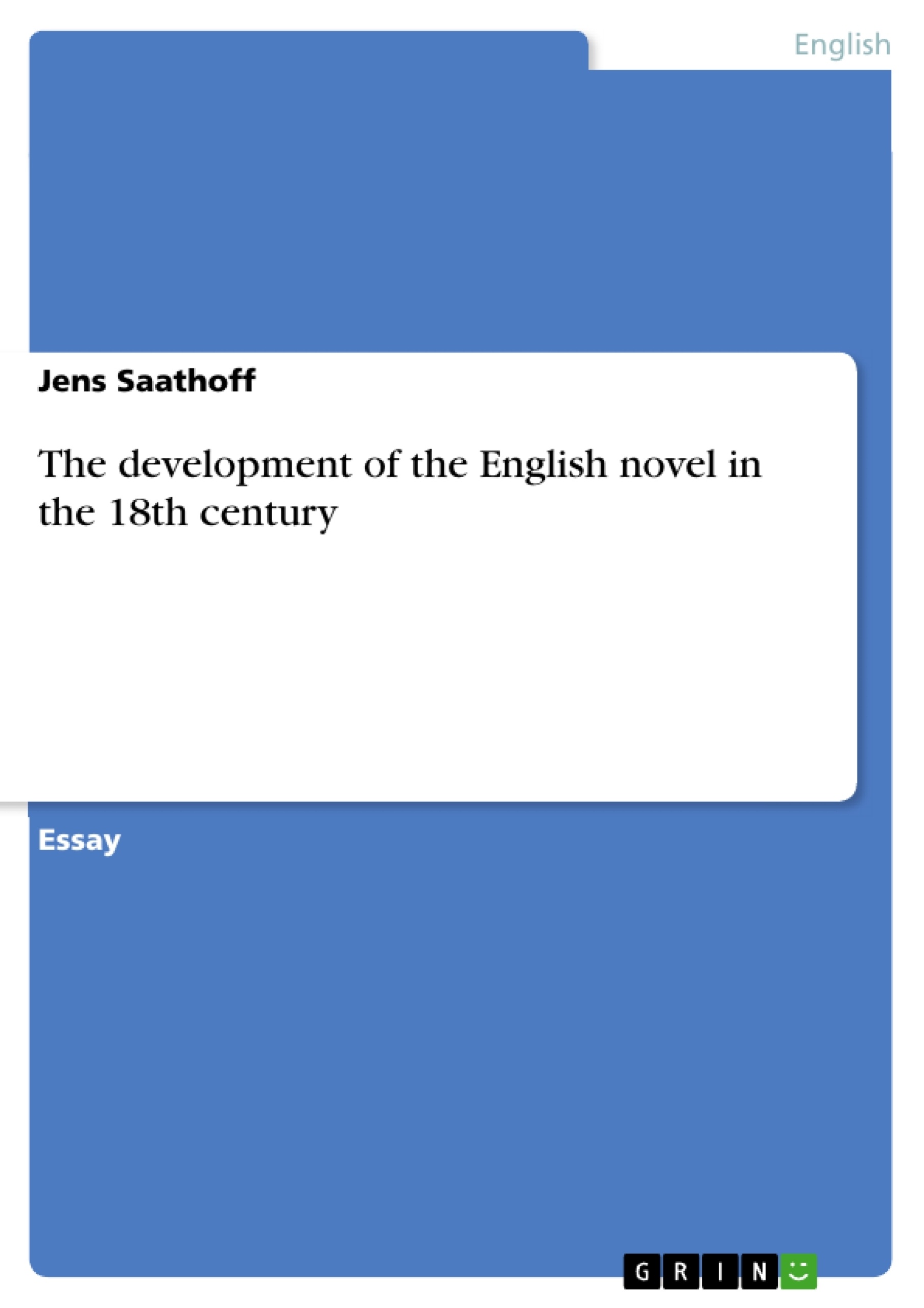What do Pamela, Tristram, Tom, Robinson, Roxana and the Monk have in common?
They are all the main characters of works that belong to the same literary genre and were written in the 18th century. The variety of works is characteristic of the novel, which may be one reason for the attractiveness of this literary form. Novels can be comic, satirical, tragic or romantic; there are epistolary, psychological and Gothic novels. All this seems to be a good reason to deal with this literary genre.
Contents
1. Introduction
2. How can the novel be distinguished from other literary forms?
3. The predecessors of the novel
4. The English novel from Defoe to Lewis
5. Conclusion
Bibliography
1. Introduction
What do Pamela , Tristram , Tom , Robinson , Roxana and the Monk have in common? They are all the main characters of works that belong to the same literary genre and were written in the 18th century.
The variety of works is characteristic of the novel, which may be one reason for the attractiveness of this literary form. Novels can be comic, satirical, tragic or romantic; there are epistolary, psychological, Gothic novels, `Bildungsromane´ and so on.[1] Interestingly enough, the novel is the youngest literary genre; it is also the literary genre women writers have been most successful in; and last but not least novels have been devoured by their readers like no other literary texts. All this seems to be a good reason to deal with this literary genre.[2]
Before I start to describe the development of the English novel I would like to point out the traits that make the novel a literary genre of its own.
2. How can the novel be distinguished from other literary forms?
Firstly, the novel is an extended text of fiction. Since it is an extended work, it can be distinguished from short stories and narratives of middle length such as novelettes. Secondly, the novel is written in prose. This trait makes it different from the long narratives in verse which were, for example, written by Chaucer or Spenser. The extension of the novel permits the author to develop a complicated plot, to introduce many characters and motifs, to portray the characters in detail and to show how they change their opinions and attitudes during the story.[3] The author of a novel does not only want to tell the reader a certain tale, but uses the tale to describe the characters, their emotions, passions and their lives in a specific historical context. This shows what the differences between a mere tale and a novel are.[4]
So we can say that the novel has specific features or traits which distinguish it from other narratives and thus it constitutes a literary genre in its own right.
3. The predecessors of the novel
The English term `novel´ derives from the Italian `novella´, which means `a little new thing´ and is the name for a short tale in prose. This kind of narrative was very popular in the 14th century. Today the term `novellette´ (and in Germany `Novelle´) is used to describe this type of literary text.[5] Another earlier literary form that exerted much influence on the novel is the picaresque narrative. It is structured into episodes, often satirical and deals with the queer adventures of a rogue. A famous example of a picaresque is Don Quixote, which was written in 1605. But picaresque elements can also be found in later novels, for example, in Felix Krull by Thomas Mann. The `character´ and the `romance´ are also said to be predecessors of the novel.[6] All these literary forms contributed to the genesis of the novel, but it was not until the 18th century that the book was written which today most people consider to be the first novel.
[...]
[1] M. H. Abrams: A glossary of literary terms. Holt, Rinehart and Winston: 5th edition Fort Worth 1988, pp. 118-122.
[2] Ifor Evans: Geschichte der englischen Literatur. Aus d. Engl. Übertr. von Paul Baudisch. München: Beck 1983 p. 171.
[3] M. H. Abrams: A glossary of literary terms, pp. 117f.
[4] Ifor Evans: Geschichte der englischen Literatur, p. 170.
[5] M. H. Abrams: A glossary of literary terms, p. 118.
[6] Ibid, pp. 118f.
- Citar trabajo
- Dr. Jens Saathoff (Autor), 1993, The development of the English novel in the 18th century , Múnich, GRIN Verlag, https://www.grin.com/document/212126
-

-

-

-
¡Carge sus propios textos! Gane dinero y un iPhone X. -

-
¡Carge sus propios textos! Gane dinero y un iPhone X. -

-
¡Carge sus propios textos! Gane dinero y un iPhone X. -

-
¡Carge sus propios textos! Gane dinero y un iPhone X. -

-
¡Carge sus propios textos! Gane dinero y un iPhone X.

